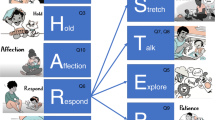Abstract
Reading aloud to infants continues to be the focus of controversy between educators, researchers, and health care professionals. This article will provide insight into what research says about reading aloud to infants as well as the results of a case study of a six-month-old infant who has been read aloud to in utero to the present time. The results of this case study confirm that parents and caregivers reading aloud to infants is necessary in developing literacy skills that are paramount to book awareness, print awareness, vocabulary development, fluency, and comprehension, all of which are stepping stones to learning to read and write.
Similar content being viewed by others
References
Anderson, R. C. (1984). Becoming a nation of readers: The report on the commission of reading, Pittsburgh, PA: National Academy of Education.
Berk, L. E., & Winsler, A. (1985). Scaffolding children’s learning. Vygotsky and early childhood education. Washington, DC: National Association for the Education of Young Children.
Brenner, D., Hiebert, E., Holland, J. W., Miles, R., Riley, M. H., & Tompkins, R. (2007). Eyes on text: Understanding opportunity to read in reading first classrooms. Paper presented at the annual meeting of the National Reading Conference.
Calkins, L. (2000). Let the words work their magic. Instructor, 110(3), 25–28.
Curtis, G. B., & Schuler, J. (2005). Your baby’s first year week by week. Cambridge, MA: Da Capo Lifelong.
De l’Etoile, S. K. (2006). Infant behavioral responses to infant-directed singing and other maternal interactions. Infant Behavior and Development, 29(3), 456–470.
DeLoache, J. S., & Mendoza, O. A. P. (1987). Joint picturebook interactions of mothers and one-year-old children. British Journal of Development Psychology, 5, 111–123.
Honig, A. S., & Shin, M. (2001). Reading aloud with infants and toddlers in child care settings: An observational study. Early Childhood Education Journal, 28(3), 193–197.
Jusczyk, P. W., & Hohne, E. A. (1997). Infants’ memory for spoken words. Science, 277(5334), 1984–1986.
McMahon, R. (1996). Introducing infants to the joy of reading. Dimension of Early Childhood, 24, 236–239.
Murkoff, H., Eisenberg, A., & Hathaway, S. (2003). What to expect the first year. New York: Workman Publishing.
Nash, M. (1997). Fertile minds in special report: How a child’s brain develops. Time, 149(23), 48–56.
Ninio, A. (1983). Joint book reading as a multiple vocabulary acquisition device. Child Development, 54, 445–451.
Shore, R. (1997). Rethinking the brain: New insights into early development. New York: Families and Work Institute.
Snow, C. E., & Goldfield, B. A. (1983). Turn the page please: Situation specific language acquisition. Journal of Child Language, 10, 551–569.
Author information
Authors and Affiliations
Corresponding author
Rights and permissions
About this article
Cite this article
Holland, J.W. Reading Aloud with Infants: The Controversy, the Myth, and a Case Study. Early Childhood Educ J 35, 383–385 (2008). https://doi.org/10.1007/s10643-007-0203-6
Published:
Issue Date:
DOI: https://doi.org/10.1007/s10643-007-0203-6



